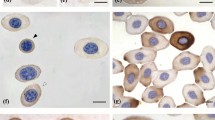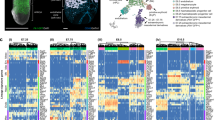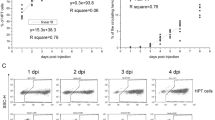Abstract
IN an atlas of avian blood cell formation, Lucas and Jamroz1 have illustrated the erythrocytes of the chicken embryo during the course of development. I have reported similar observations2 and have extended the examination of these cells to include histochemical data3. The undisputed conclusion from these investigations is that there are two lines of erythroid cells during chicken embryogeny, with the definitive line replacing the primitive one at 6–8 days of development, except for some mature elements of the primitive series which persist until approximately the thirteenth day.
This is a preview of subscription content, access via your institution
Access options
Subscribe to this journal
Receive 51 print issues and online access
$199.00 per year
only $3.90 per issue
Buy this article
- Purchase on Springer Link
- Instant access to full article PDF
Prices may be subject to local taxes which are calculated during checkout
Similar content being viewed by others
References
Lucas, A. M., and Jamroz, C., Atlas of Avian Hematology (U.S. Dept. Agric., Washington, D.C., 1961).
Fraser, R. C., Exp. Cell Res., 25, 418 (1961).
Fraser, R. C., J. Exp. Zool., 152, 297 (1963).
Fraser, H. C., Exp. Cell Res. (in the press).
Author information
Authors and Affiliations
Rights and permissions
About this article
Cite this article
FRASER, R. Lineage of Embryonic Chick Erythrocytes by Means of Autoradiography. Nature 202, 518–519 (1964). https://doi.org/10.1038/202518a0
Issue Date:
DOI: https://doi.org/10.1038/202518a0
Comments
By submitting a comment you agree to abide by our Terms and Community Guidelines. If you find something abusive or that does not comply with our terms or guidelines please flag it as inappropriate.



